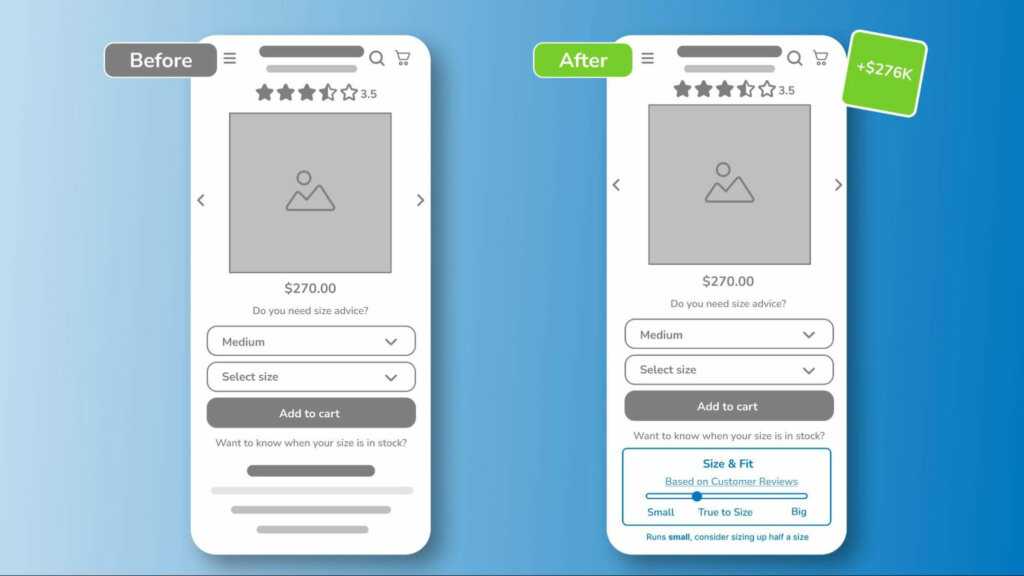
How to Leverage Product Reviews to Improve Conversion Rates
There's nothing more valuable than a happy customer. They are essential to building trust with your potential buyers through product reviews.
New customers don’t know how great your products are, even if you put flashing neon lights on the screen.
So, how can you convince them to trust you, your product, and your company?
One foolproof way to start building that trust is with social proof, and more specifically, with product reviews.
PowerReviews found that 97% of consumers read product reviews and ratings before making a purchase decision.
This is why you can’t ignore social proof and the power of ecommerce product reviews.
Granted, ecommerce product reviews can be a two-headed monster. Allowing potential customers to see reviews can increase your conversion rate. But should you allow negative product reviews on your site and risk turning buyers away, or only allow positive reviews and risk appearing dishonest? It’s a tricky question.
Whichever method you choose, you definitely need to have reviews on your website and product pages.
What Is Social Proof?
Social proof is a psychological phenomenon that has been studied extensively.
It centers around the idea that the more people there are doing something, the more likely it is that others will do it as well. This is known as the “bandwagon effect.”
Social proof can be used to influence people’s decisions in a variety of situations, including product purchases, brand choices, and even political elections.
For ecommerce brands, social proof is a marketing method that involves others promoting your products or services in some manner. It is one of the most powerful tools of persuasion that sellers can employ on their sites.
Some examples include:
- Reviews: Positive reviews from customers can help to build trust and credibility.
- Testimonials: Testimonials from satisfied customers can be a powerful way to persuade potential customers.
- Social media mentions: When people mention your products or services on social media, it can help to create a buzz and attract new customers.
- Brand ambassadors: Brand ambassadors are people who promote your products or services to their own social networks.
- Limited-time offers: Limited-time offers can create a sense of urgency and scarcity, which can lead to more sales.
Today we are going to dive into one specific element of social proof: product reviews. But, keep in mind that for all tactics, the best way to use social proof is to be authentic and genuine. People can spot fake social proof a mile away.
Why Are Ecommerce Product Reviews So Important?
Every brand owner should know that there is nothing more valuable than a happy customer. Given the general level of distrust online, product reviews can be the first step to building trust and establishing a relationship with a potential buyer.
As shoppers, we tend to consider reviews as more trustworthy than the copy written by the seller. After all, in most cases, the reviewers are giving their honest opinions about the product without any ulterior motives.
In fact, a 2023 survey from BrightLocal found that 49% of customers trust product reviews like they trust recommendations from their loved ones. In short, they have the power to make or break a sale.
Another report also noted that as the price of a product increases, the importance of reviews also increases. Specifically, “when reviews were displayed for a lower-priced product, the conversion rate increased by 190%. However, for a higher-priced product, the conversion rate increased 380%.”
That’s a huge impact that any ecommerce manager would be silly to turn their back on.
If that wasn’t enough to convince you of their importance, if an ecommerce store doesn’t have product reviews, customers will go elsewhere to find them, such as Amazon or product review websites.
This is bad news for any ecommerce store.
When customers go elsewhere for reviews, the brand loses control of how the product is portrayed, as well as surrounding details such as product specifications, key benefits, etc.
It also usually means that the consumer will purchase the product from the website where they found the reviews and had their questions answered instead of purchasing directly from your ecommerce store.
Bottom line: You need ecommerce product reviews.
Of course, this raises the critical question: How do you get your customers to write reviews?
How to Motivate Customers to Write Product Reviews
If you want customers to write reviews, the first step is pretty obvious: ask them to do it.
You can prime shoppers for reviews by letting your customers know three things immediately after the transaction is completed:
- You want them to be 100 percent satisfied with their purchases.
- If they aren’t satisfied, you want to know so you can correct the problem.
- Once they are completely satisfied, you would appreciate an honest review.
You should have a system in place that automatically asks customers to review your products after they’ve had them for a certain length of time. Obviously, you don’t want to ask too early because they won’t have had enough time to enjoy the benefits of the product. We often recommend asking for reviews as one step in a series of post-purchase emails.
A review request email asks the customer to leave a review of the product or to rate the experience they had with you. To show your appreciation, you can offer them a gift or store credit. This will not only strengthen the trust and positive relationship, but it will also encourage them to come back for future transactions.
This email from Hollister is a perfect example of a request review. They offer customers a chance to win $100 in store credit in exchange for the review and already included a CTA button that the customer has to click, making the process very enticing, straightforward, and clear for the customer.

Ideally, this email should be sent after enough time has elapsed for them to try the product for a few weeks.
The review email can also include:
- A reminder to customers about the great product or experience you provided, usually using an image.
- Honest and upfront information about how long the survey will take.
- A description of how the review or results of the survey will benefit the customer.
Everything You Need To Know About Building A Product Page That Converts

Quality and Credibility Are Key
When it comes to ecommerce product reviews, quality and credibility matter greatly. Well-written, thorough, thoughtful reviews will help the customer make an informed purchasing decision. On the flip side, short reviews that lack substance won’t do much to motivate the customer to purchase.
42% of people are confident that they have encountered fake reviews. Therefore, the most effective reviews—the ones that seem the most authentic—tend to be balanced reviews. The customers are generally happy with the product without seeming as though it’s the greatest thing they’ve ever purchased.
The data seems to back this up. To quote the Spiegel Research Center:
“Is five stars “too good to be true” in the eyes of consumers? According to our research, it is. Across product categories, we found that purchase likelihood typically peaks at ratings in the 4.0 – 4.7 range, and then begins to decrease as ratings approach 5.0.”
When choosing whether or not to purchase, the average rating customers tend to expect is, at least, 3.3 stars. If you get a rating lower than this, the customer will probably consider a competitor instead. In other words, no one expects a product to be perfect, and if a product only has glowing, five-star ratings, customers will suspect that something is off.
Your goal is to secure in-depth reviews that go beyond “Five stars – great product.”
And here’s one more thing to consider: Grammar and spelling actually matter a great deal when it comes to reviews. The quality of the review matters to customers making purchase decisions.
One final reason to make every effort to secure good reviews is that it will help in your overall SEO efforts. User-generated content, such as reviews, are looked upon favorably by Google and can help you outrank your competitors in Google searches.
Do everything in your power to secure well-written, in-depth, thoughtful reviews from your customers. Not only will they boost your conversion rate, but they’ll also have a significant impact on your SEO efforts.
Looking for more information on how you should go about leveraging product reviews on your site? Check out our video breakdown of how to optimize an actual product detail page.
3 Proven Strategies For Implementing Ecommerce Product Reviews
Some brands receive the reviews and stop there. But what happens after? Here are three ways you can make use of product reviews and boost your conversions.
1. Turn Product Reviews Into A Useful Tool For Customers
Instead of letting a review stop at a star rating, ask the shopper for useful information. For example: How did the product fit? And was it true to size? Then turn that data into a tool to help other customers.
Here’s a real example from one of our clients at The Good.
The ecommerce clothing brand was receiving customer reviews, but after user testing and research, our team hypothesized that adding fit based on customer reviews would give customers more confidence when purchasing a product.
So, we ran a test that added a size and fit scale based on customer ratings, and it was a winner.
Based on the lift in per session value, implementing the winning variant to all users would produce a lift in annualized revenue of over $276,000.

In this case, using the reviews to help customers gain confidence in the size and fit of their purchase both improved the user experience and increased transactions.
2. Feature Best Sellers & Elevate Reviews To The Homepage
Product reviews can live across your site, not just on the product page. And sometimes, elevating best-selling items on the homepage helps narrow “window shoppers” narrow down the options and get a clearer path to purchase.
We have seen this work well across clients, here is an example.
After seeing in research that users were presented with too many options on the homepage, we hypothesized that elevating reviews and best sellers would increase visibility of social proof, increasing users’ likelihood to engage with content.

Adding best-selling products higher on the homepage allowed users to see ratings and the number of reviews on their top products and made them more likely to purchase. The result was over $200k in additional revenue.
3. Include Reviews Throughout Your Site
Another winning strategy for implementing product reviews on your ecommerce site is to build them into category pages.
We have seen that social proof on category pages breaks up product tiles and gives more visibility into brand differentiation.
For one client specifically, we hypothesized that showing content blocks with social proof and brand differentiators on filter (category) pages would improve users’ likelihood to convert.

If implemented, the variant, which added content blocks in between tiles to elevate social proof and brand differentiators, would produce over $255,000 in annualized revenue gains.
These are just three of many winning strategies we’ve found for clients. How you implement product reviews will depend on your customer, product, and brand. But hopefully, these examples can help inspire you to not just slap them on the product page and be done with it.
Instead, consider how your customers would most like to see the reviews, and what would help them make a purchase decision (or drive them further down the funnel).
How to Manage Negative Reviews
Inevitably, you’re going to get negative reviews from time to time; that’s simply part of the ecommerce business. However, there’s a growing need for transparency today. No business should seek negative reviews, but allowing the positive and the negative to co-exist on your site adds authenticity for your customers. It’s how you handle those negative reviews that can make a difference.
Step 1: Learn from them. Criticism can be a valuable teacher. Assess and improve upon your product. Examine what customers are not satisfied with, and how you can start to improve on that. Negative reviews, believe it or not, can actually end up benefiting your business.
Step 2: Approve the bad reviews. Yes, it might be tempting to delete them, but don’t. The reality is that if you only have positive reviews on your site, you lose credibility with customers. Nothing is perfect, and customers won’t believe that you or your products are. If they don’t see a single negative review, they’ll become skeptical.
Note: It’s important to only approve negative reviews from verified buyers. If you don’t have a system for verifying reviewers, what’s stopping your competition from going on your site and leaving a series of negative reviews?
Step 3: Respond appropriately to negative reviews. This doesn’t mean that you have to offer a full refund in every case. It simply means that you need to express real interest in the problem and put a good-faith effort into fixing it. You want to show customers that you genuinely do stand behind your products and take problems seriously.
Step 4: Respond with gratitude to positive reviews. If a customer takes the time and effort to leave you a positive review, you should take the time to acknowledge it and express your appreciation. If someone said to you in person, “I love your products and tell everyone about them,” wouldn’t you thank that person? Treat your online customers in the same way.
Product Reviews Are Essential
In an age of abundant choices, product reviews are more essential now than ever before.
They function as social proof, demonstrating that your products are trustworthy and likely worth purchasing.
They improve the overall user experience on your website, boost your conversion rate, and aid your SEO efforts.
Don’t know where to start with collecting and utilizing product reviews on your website? Contact The Good.


About the Author
Caroline Appert
Caroline Appert is the Director of Marketing at The Good. She has proven success in crafting marketing strategies and executing revenue-boosting campaigns for companies in a diverse set of industries.